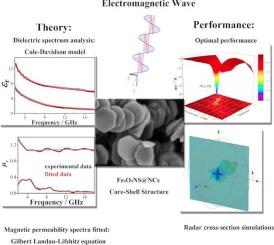Electromagnetic wave loss properties of N-doped carbon-coated Fe3O4 nanosheets: A spectrum analysis study
IF 6.9
2区 材料科学
Q2 CHEMISTRY, PHYSICAL
引用次数: 0
Abstract
Carbon-based magnetic composites are recognized for their excellent electromagnetic wave (EMW) loss capabilities, which arises from the synergistic effect of dielectric loss and magnetic loss. However, the intricate composition-structure–property relationships in these composites remain poorly understood due to their structural complexity. Herein, we systematically investigate the EMW loss properties in two-dimensional N-doped carbon-coated Fe3O4 nanosheet (Fe3O4NS@NCs) through combined experimental and theoretical approaches. In particular, the Cole–Davidson (C–D) model was employed to simulate the dielectric spectra, from which key fitting parameters (including relaxation frequency, electrical conductivity and dielectric strength) were extracted. Quantitative comparison of these parameters across different Fe3O4NS@NCs contents (30–50 wt%) revealed content-dependent dielectric relaxation behavior. Furthermore, the Gilbert-modified Landau-Lifshitz (LLG) equation successfully modeled the permeability spectra, identifying three characteristic resonance peaks at 3.3, 4.5, and 8.5 GHz. Theoretical analysis based on Aharoni’s exchange resonance theory confirmed that the multiple resonances originate from intergranular magnetic coupling. The unique anisotropic architecture and Fe3O4/C interfacial synergy endow the Fe3O4NS@NCs with threefold enhancement mechanisms: (i) the intensified magnetic resonance, (ii) optimized dielectric relaxation, and (iii) improved impedance matching. These synergistic effects result in exceptional broadband absorption performance, achieving reflection loss (RL) lower than −10 dB (corresponding to 99.9 % absorption) in a large frequency (f) range of 4.1–18.0 GHz with a minimum RL (RL, min) of −50.2 dB at f = 7.6 GHz (thickness: 3.5 mm). Radar cross-section (RCS) simulations corroborate these findings, demonstrating a significant RCS reduction of −18.77 dBm2 at the target frequency. This study fundamentally elucidates the dielectric/magnetic loss properties in carbon-based magnetic composites, establishing a design paradigm for tunable electromagnetic absorbers.

n掺杂碳包覆Fe3O4纳米片电磁波损耗特性的波谱分析研究
碳基磁性复合材料由于介质损耗和磁损耗的协同作用而具有优异的电磁波损耗能力。然而,由于其结构的复杂性,这些复合材料中复杂的成分-结构-性能关系仍然知之甚少。本文采用实验和理论相结合的方法,系统地研究了二维n掺杂碳包覆Fe3O4纳米片(Fe3O4NS@NCs)的EMW损耗特性。特别采用Cole-Davidson (C-D)模型对介质谱进行模拟,从中提取关键拟合参数(包括弛豫频率、电导率和介电强度)。这些参数在不同Fe3O4NS@NCs含量(30-50 wt%)上的定量比较揭示了与含量相关的介电弛豫行为。此外,Gilbert-modified Landau-Lifshitz (LLG)方程成功地模拟了磁导率谱,确定了3.3、4.5和8.5 GHz的三个特征共振峰。基于Aharoni交换共振理论的理论分析证实了多重共振源于晶间磁耦合。独特的各向异性结构和Fe3O4/C界面协同作用赋予Fe3O4NS@NCs三重增强机制:(i)增强磁共振,(ii)优化介电弛豫,(iii)改善阻抗匹配。这些协同效应导致了卓越的宽带吸收性能,在4.1-18.0 GHz的大频率(f)范围内,反射损耗(RL)低于−10 dB(对应于99.9 %的吸收),在f = 7.6 GHz(厚度:3.5 mm)时,最小RL (RL, min)为−50.2 dB。雷达横截面(RCS)模拟证实了这些发现,表明在目标频率下RCS显著降低- 18.77 dBm2。本研究从根本上阐明了碳基磁性复合材料的介电/磁损耗特性,建立了可调谐电磁吸收器的设计范例。
本文章由计算机程序翻译,如有差异,请以英文原文为准。
求助全文
约1分钟内获得全文
求助全文
来源期刊

Applied Surface Science
工程技术-材料科学:膜
CiteScore
12.50
自引率
7.50%
发文量
3393
审稿时长
67 days
期刊介绍:
Applied Surface Science covers topics contributing to a better understanding of surfaces, interfaces, nanostructures and their applications. The journal is concerned with scientific research on the atomic and molecular level of material properties determined with specific surface analytical techniques and/or computational methods, as well as the processing of such structures.
 求助内容:
求助内容: 应助结果提醒方式:
应助结果提醒方式:


